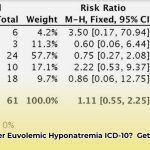Your body depends on a precise sodium balance to function correctly, much like a recipe needing the right ingredients. Too much or too little sodium can disrupt this delicate balance, potentially leading to various health issues. This guide explains normal serum sodium levels, the consequences of imbalances (hyponatremia and hypernatremia), and actionable steps to maintain healthy levels. We’ll explore causes, symptoms, diagnosis, treatment, and prevention in an accessible way, providing valuable insights for both patients and healthcare professionals. For more on hyponatremia ICD codes, see this helpful resource: ICD-10 codes.
Serum Sodium Levels: Your Body’s Salty Secret
Serum sodium levels, reflecting the concentration of sodium in your blood, are crucial indicators of overall health. Sodium, an essential mineral that functions as an electrolyte, regulates bodily fluids, transmits nerve signals, and supports muscle function. Maintaining the right balance is key, as deviations can signal underlying health problems.
What’s a Normal Sodium Level?
A healthy serum sodium range typically falls between 135 and 145 milliequivalents per liter (mEq/L). This “sweet spot” indicates proper sodium balance. Values outside this range warrant medical evaluation, with low levels indicating hyponatremia and high levels suggesting hypernatremia. Note that reference ranges may vary slightly between labs.
Hyponatremia: When Your Sodium is Low
Hyponatremia is characterized by serum sodium levels below 135 mEq/L and can arise from various factors. Excessive water consumption, causing sodium dilution, vomiting, diarrhea, significant blood loss, severe burns, or the use of certain medications can lead to this condition. Underlying medical conditions, like kidney disease, heart failure, and liver cirrhosis, can also cause hyponatremia.
Symptoms: Mild hyponatremia may cause no noticeable symptoms. More significant drops in sodium can lead to headaches, nausea, muscle weakness, confusion, and fatigue. Severe cases can result in seizures, coma, or even death, emphasizing the importance of early detection.
Diagnosis: A simple blood test can accurately measure your serum sodium level. Additional tests, such as a urine sample to measure sodium and osmolality, kidney and liver function tests, and a review of medications, may help pinpoint the underlying cause. Your doctor will also consider your medical history and perform a physical examination to help in the diagnosis.
Treatment: Treatment strategies depend on the root cause, severity, and rapidity of onset, and the patient’s extracellular fluid volume status. Options include:
- Fluid Restriction: Limiting fluid intake if excess water is the primary cause.
- Intravenous (IV) Sodium Chloride: Administering IV saline solutions to slowly and carefully raise sodium levels. The rate of correction is critical to avoid complications.
- Medication Adjustments: Switching or adjusting medications that may be contributing to hyponatremia. Diuretics are common culprits.
- Treating Underlying Conditions: Managing underlying medical conditions such as heart failure, kidney disease, or SIADH (syndrome of inappropriate antidiuretic hormone).
- Vaptans: In some cases, medications called vaptans may be used to promote water excretion without sodium loss.
Treatment should be administered under close medical supervision due to the risk of complications if sodium levels are corrected too quickly.
Hypernatremia: When Your Sodium is High
Hypernatremia occurs when serum sodium levels exceed 145 mEq/L, often due to excessive water loss relative to sodium, or less commonly, excessive sodium intake. Dehydration from insufficient fluid intake, particularly in infants and the elderly, diarrhea, vomiting, certain illnesses, or medications, including some over-the-counter drugs, can contribute to hypernatremia. Diabetes insipidus, a condition causing the body to lose too much fluid in the urine, can also lead to hypernatremia.
Symptoms: Extreme thirst and confusion are common symptoms. Other symptoms include lethargy, weakness, irritability, and muscle twitching. Severe cases can lead to seizures, coma, or brain damage. Prompt medical intervention is essential.
Diagnosis: Elevated sodium levels are readily detected through a blood test. Further investigations, such as a review of medications, assessment of fluid intake and output, and urine tests, can help determine the underlying cause. A water deprivation test may be performed to evaluate for diabetes insipidus.
Treatment: Rehydration, typically with oral or IV fluids, is central to treating hypernatremia. The type of fluid and rate of administration depend on the severity of hypernatremia, the patient’s fluid status, and underlying medical conditions. Addressing the root cause is also crucial for safe and effective management. This may involve:
- Fluid Replacement: Providing fluids orally or intravenously to correct dehydration.
- Medication Adjustments: Stopping or adjusting medications that contribute to hypernatremia.
- Treating Underlying Conditions: Managing conditions like diabetes insipidus.
- Dietary Changes: Reducing sodium intake, although this is rarely the sole treatment.
Professional medical attention is crucial for safe and effective management. Rapidly correcting hypernatremia can be dangerous and lead to cerebral edema.
What Increases Your Risk of Sodium Imbalances?
Several factors can increase your susceptibility to sodium imbalances.
- Age: Infants and the elderly are particularly vulnerable due to immature or declining kidney function and reduced thirst sensation.
- Medical Conditions: Chronic kidney disease, heart failure, liver disease, diabetes, and adrenal gland disorders are significant risk factors.
- Medications: Diuretics (“water pills”), certain antidepressants, NSAIDs (nonsteroidal anti-inflammatory drugs), and some antipsychotics can affect sodium levels.
- Lifestyle Factors: Excessive sweating, prolonged vomiting or diarrhea, and drinking too much or too little water can disrupt sodium balance.
- Hormonal Imbalances: Conditions affecting hormones that regulate fluid balance, such as ADH (antidiuretic hormone) and aldosterone, can increase risk.
Maintaining adequate hydration, discussing medication changes with your doctor, and managing underlying medical conditions are vital preventive measures.
When Should You See a Doctor?
Seek medical attention promptly if you experience symptoms such as:
- Excessive thirst
- Unexplained confusion or altered mental status
- Muscle weakness, cramps, or spasms
- Nausea, vomiting, or diarrhea
- Seizures
- Significant changes in urine output
- Dizziness or lightheadedness
Early diagnosis and treatment are essential to prevent serious complications from hyponatremia or hypernatremia.
Your Doctor’s Role in Managing Sodium Levels
Your doctor plays a crucial role in diagnosing and managing sodium imbalances. They will evaluate your medical history, perform a physical examination, order appropriate blood and urine tests, interpret the results in the context of your overall health, and recommend the best treatment plan. This may involve adjusting medications, treating underlying conditions, providing fluid management strategies, and monitoring your sodium levels regularly. Collaborating with your medical team and asking questions are key to better health management.
Understanding Your Serum Sodium Levels: Key Points to Remember
Maintaining healthy serum sodium levels is critical for overall health. Sodium imbalances can have serious consequences, but they are often treatable with appropriate medical care.
- Know Your Numbers: Discuss your sodium levels with your doctor and understand what is considered normal for you, especially if you have underlying medical conditions.
- Stay Hydrated: Drink adequate fluids, especially during hot weather or strenuous activity, but avoid excessive water intake.
- Be Aware of Medications: Know the potential side effects of your medications, particularly those that can affect sodium levels.
- Manage Underlying Conditions: Work with your doctor to effectively manage any medical conditions that may contribute to sodium imbalances.
- Seek Medical Attention: Don’t ignore symptoms that may indicate a sodium imbalance. Early diagnosis and treatment can prevent serious complications.
This information provides a general overview and is not a replacement for professional medical advice. Ongoing research refines our understanding of sodium balance and its impact on health. Consult your doctor or a registered dietitian for personalized guidance and to address concerns regarding your sodium levels and overall health. Early detection and management are paramount to prevent severe health issues.
How to Interpret Low Sodium Blood Test Results in Patients with Chronic Kidney Disease
Key Takeaways:
- Hyponatremia (low sodium) is common in chronic kidney disease (CKD).
- Understanding its causes is crucial for effective management.
- Treatment varies based on severity and underlying causes, and must be closely supervised by a physician.
Understanding Serum Sodium: The Basics
Sodium, an electrolyte, maintains fluid balance and nerve and muscle function. Serum sodium levels are measured in milliequivalents per liter (mEq/L), with a normal range of 135-145 mEq/L. This balance significantly affects the patient’s general health. In CKD, sodium imbalances are particularly common due to the kidneys’ impaired ability to regulate fluid and electrolyte balance.
Decoding Low Sodium in CKD Patients: How to Interpret Low Sodium Blood Test Results in Patients with Chronic Kidney Disease
In chronic kidney disease (CKD), hyponatremia presents unique challenges because kidney damage affects the body’s ability to regulate fluid and sodium. So, how do we interpret these results? It’s crucial to understand that hyponatremia in CKD can be multifactorial.
Your doctor needs the full picture, as it’s not just about the sodium serum number:
- Your Symptoms: Nausea, vomiting, confusion, muscle weakness, or seizures can signal severe hyponatremia. These symptoms can overlap with other CKD-related
- Wellness Fair Ideas for Work to Boost Employee Wellbeing - December 15, 2025
- Affordable Employee Wellness Fair Ideas for Any Budget - December 14, 2025
- Employee Wellness Programs Strategically Benefit Employee Health And Retention - December 13, 2025
















